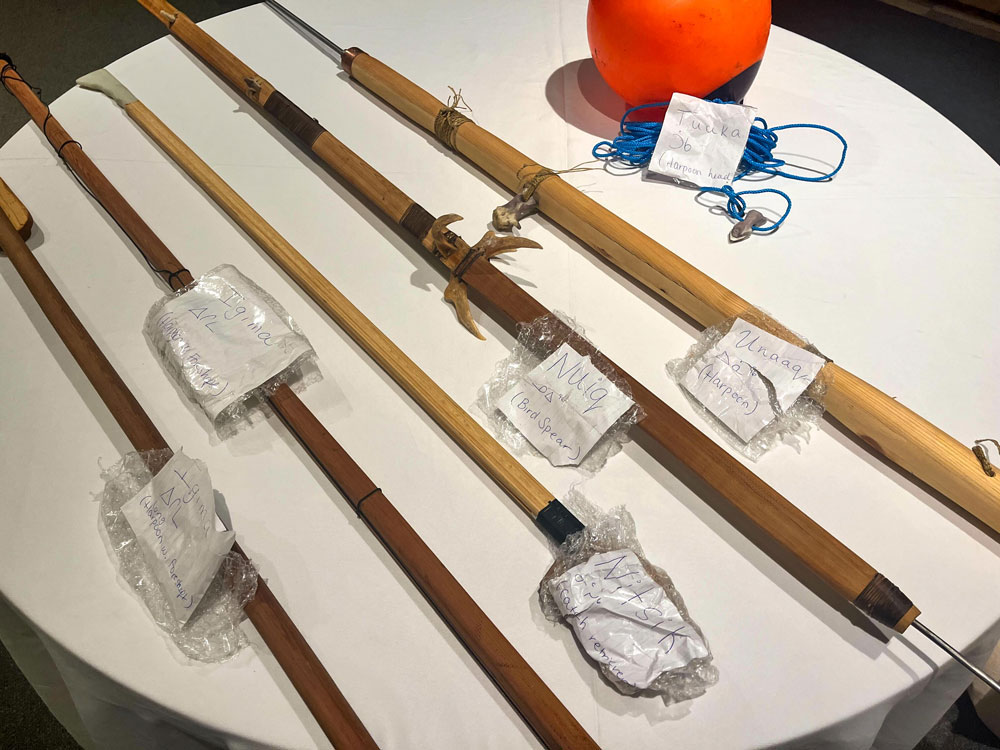As an organization that stewards the world’s largest and most significant collection of canoes, kayaks & paddled watercraft, The Canadian Canoe Museum honours and shares the cultural histories and stories within the collection. Building a new facility has empowered the Museum to continue celebrating multiple voices and languages within the new exhibition more so than ever before. Forming and fostering reciprocal relationships has included knowledge sharing within Indigenous and non-Indigenous communities across the continent and supporting watercraft-build projects.

Through National Council Member Robert Comeau, The Canadian Canoe Museum has partnered with the Qajakkut Society, an Iqaluit-based organization, aimed at strengthening the practice of qajaq (kayak) building and paddling. Robert Comeau, founding member and Vice-President of the Qajakkut Society and Torsten Diesel, Director of Projects, representing Inuit Heritage Trust, organized a qajaq build earlier this year with a team of local Iqaluit builders and knowledge keepers.
“The Museum is a repository of thousands of years of knowledge so it is exciting to be a part of something this significant.”
Robert Comeau, Student at Law, Qujaq Builder, Inuit Social and Cultural Historian – Nunavut
The build also featured various family connections and dynamics. Elder Eemeelayou Arnaquq was joined by his nephew Aasivak Arnaquq-Baril. Eemeelayou is also immediate kin to Robert’s grandmother. Another builder, Izaac Wilman, president of Qajakkut Society, also contributed greatly to the success of the build.
As part of this project, The Canadian Canoe Museum commissioned the Qajakkut Society to build two qajait (kayaks). Thanks to the support from Inuit Heritage Trust Inc., the builders had a workspace in Iqaluit.
Traditional knowledge and language sharing have been essential to this project by combining hands-on experiential learning with guidance from Elders in the community.
The generous support of TD Bank Group through the TD Ready Commitment has enabled The Canadian Canoe Museum and Qajakkut Society to document each step of the process, emphasizing language and knowledge transmission between Elders and builders.
This work has included recording regionally specific audio in Inuktitut of different qajaq parts and translating first-hand quotes that will appear in exhibits in the Museum’s new Exhibition Hall. Adding to the family affair, Aasivak’s mother Naulaq Arnaquq provided these translations. Plans and diagrams featuring Inuktitut (the Inuit language spoken in the central and eastern Canadian Arctic) were also developed and shared among participants.
Elder Eemeelayou Arnaquq shares Inuktitut terms in the Uqqurmiut-South Baffin dialect. The term ‘apumak’ translates to ‘gunwales’.
Through this project, the Qajakkut Society is ensuring the learning and work accomplished remain within the community for generations to come. This includes working with Anguti Johnston and his videography team to record the entire build process, and interview Elders.
The Canadian Canoe Museum aims to be a learning hub and sharing space for watercraft culture from coast to coast to coast. We are fortunate and proud to work with the Qajakkut Society.
Much of the learning and dialogue that has taken place in Iqaluit will be part of The Canadian Canoe Museum’s new exhibits, fostering a space of learning and connection for those wishing to explore the ingenuity and technology of watercraft construction.

These recordings and language resources, along with the qajaq, will be featured in the exhibit Design, Ingenuity and the Maker. Learn more about the 20,000 square feet of brand-new exhibits that will be yours to explore in the new Exhibition Hall.
With the Indigenous Languages Program, supported by TD Bank Group through the TD Ready Commitment, The Canadian Canoe Museum is working with Indigenous Peoples across the continent to ensure visitors will see and hear languages and voices from Indigenous communities the moment they arrive at the Museum.
This includes using the local Michi Saagig dialect of Anishnaabemowin throughout the Museum and within exhibits alongside English and French. Additional languages from Indigenous communities, including Inuktitut, will feature in relation to specific watercraft to allow stories to be shared in the first voice.
Truth & Reconciliation in Action
This project supports the United Nations Declaration of Indigenous Rights (UNDRIP) as outlined and emphasized in the Truth and Reconciliation Commission’s Calls to Action specific to museums and archives.
The following articles of UNDRIP align with the key goals of this partnership and project between The Canadian Canoe Museum and Qajakkut Society, whose mandate is to revive kayaking, kayak building and learning about Inuit kayak traditions:
Article 13
Indigenous peoples have the right to revitalize, use, develop and transmit to future generations their histories, languages, oral traditions, philosophies, writing systems and literatures, and to designate and retain their own names for communities, places and persons.
Article 25
Indigenous peoples have the right to maintain and strengthen their distinctive spiritual relationship with their traditionally owned or otherwise occupied and used lands, territories, waters and coastal seas and other resources and to uphold their responsibilities to future generations in this regard.
Article 31
Indigenous peoples have the right to maintain, control, protect and develop their cultural heritage, traditional knowledge and traditional cultural expressions, as well as the manifestations of their sciences, technologies and cultures, including human and genetic resources, seeds, medicines, knowledge of the properties of fauna and flora, oral traditions, literature, designs, sports and traditional games and visual and performing arts. They also have the right to maintain, control, protect and develop their intellectual property over such cultural heritage, traditional knowledge, and traditional cultural expressions.
This project is one of many that represents The Canadian Canoe Museum’s commitment to developing reciprocal and lasting relationships with Indigenous Nations.







